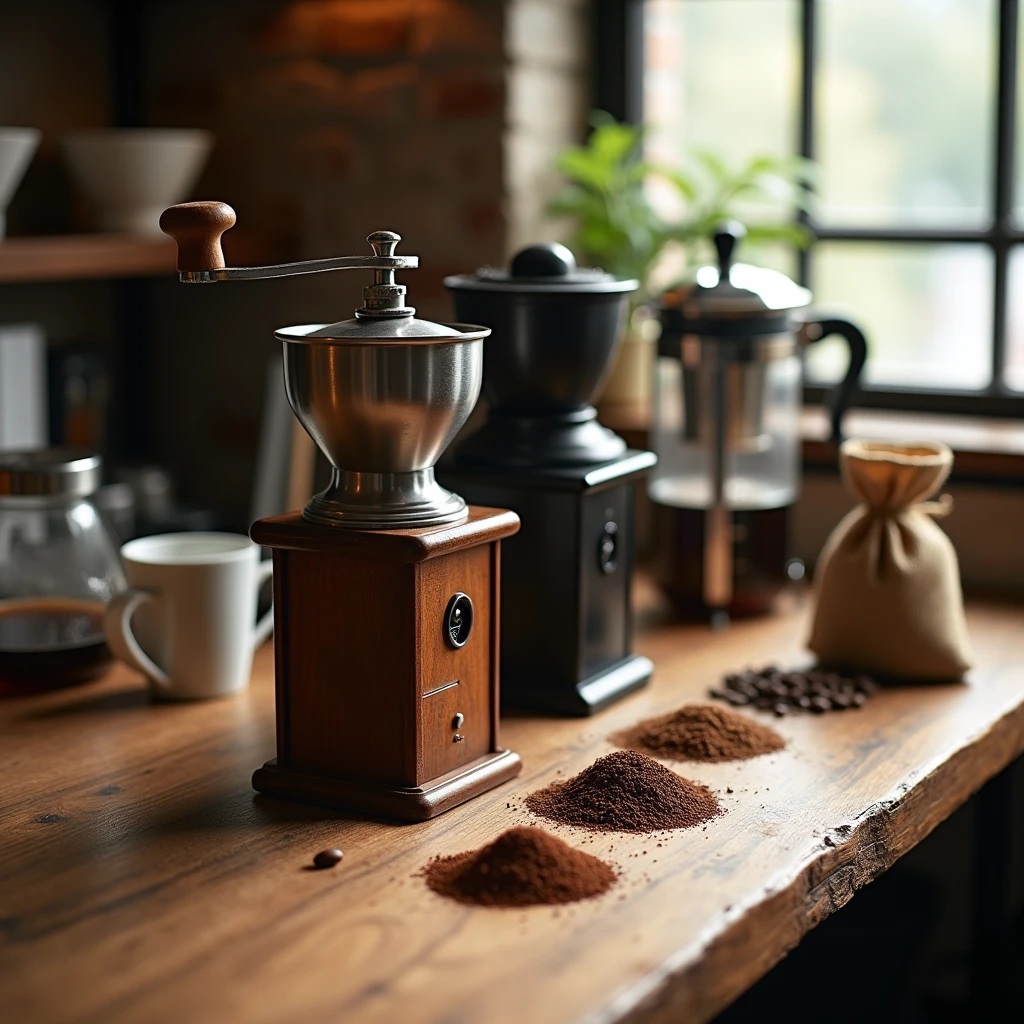Understanding Grinding for Brewing

In a previous post where we reviewed coffee preparation in general terms, we discussed the following regarding grinding:
Grinding defines the extraction in the beverage, commercially they are defined in three types, as follows:
- Fine: feels like salt to the touch, this is the recommended grind for methods such as the Italian coffee maker.
- Medium: It feels like refined (white) sugar, it is recommended for filtering methods such as drip coffee makers, V60, Melitta.
- Coarse: Feels like brown sugar and is recommended for immersion preparations such as French press.
The grind defines the speed at which the water passes through the coffee in terms of non-immersion methods. Generally speaking, the smaller the grind, the slower the water passes through. Although greater extraction is achieved, in some methods not assisted by pressure or excellent aeration, blockages may occur. When preparing by immersion, these larger particles, exposed to water for a longer time, modulate the extraction.
Getting into the nitty-gritty, let's first look at the importance of grinding coffee before brewing. The coffee grinding process plays a fundamental role in achieving the flavor and aroma that begin the ritual of enjoying a good cup of coffee. Grinding coffee just before brewing ensures it retains its freshness and sensory properties.
Freshly grinding coffee provides several notable benefits in terms of flavor and aroma. One of them is the aromatic compounds present in the coffee beans. These volatile substances are released when the beans are ground, allowing them to mix with the hot water during coffee preparation and creating a sensory experience.
Furthermore, the freshness of freshly ground coffee guarantees greater flavor intensity. By grinding the beans just before consumption, oxidation and the loss of compounds that contribute to characteristic flavors are prevented. This way, you can enjoy coffee with all its essence and nuances, without them being compromised by the time it has been ground.
The grinding process aims to extract the aromatic and flavor compounds present in the coffee beans. Breaking down the structure of the beans facilitates the release of these compounds, which, upon contact with hot water during brewing, dissolve and become part of the beverage.
Proper extraction of these compounds depends largely on the type of grind used. Each coffee brewing method requires a specific grind level to achieve the best results. A grind that is too coarse can result in a bland coffee, while a grind that is too fine can result in a bitter, over-extracted brew.
The choice of coffee grind type is closely related to the brewing method used. For example, for French presses or plunger coffee makers, a coarse grind is recommended to allow for complete extraction without sediment in the cup. On the other hand, for espresso or Italian coffee makers, a fine and consistent grind is required to achieve proper extraction in a short time.
It is essential to keep in mind this relationship between grinding and preparation method, as it will largely determine the final result in terms of flavor and aroma.
Let's now talk about the mill and its types.
- Hand mills and their portability and convenience: Manual grinders are a good option for portability and convenience. These coffee grinders don't require electricity and are ideal for those who want to enjoy fresh coffee anywhere. Their compact and lightweight design makes them easy to transport.
- Electric knife mills and their operation: Electric blade or paddle grinders are a popular choice due to their ease of use. These grinders use rotating blades to grind coffee beans. Operation is simple; just press a button, and the blades will grind the beans into smaller particles. However, it's important to keep in mind that these types of grinders can generate excessive heat during grinding, which can affect the final flavor of the coffee. This can be controlled with spaced pulses, which cool the grind and control the heating.
- Flat-grind electric mills and their influence on extraction and flavor: Electric flat burr grinders are a more precise and versatile option. They use rotating flat burrs to grind coffee beans evenly. This consistent grind allows for more precise extraction of aromatic and flavor compounds, resulting in a more balanced and flavorful cup of coffee. Additionally, these grinders often allow you to adjust the grind level to suit your specific brew.
- Manual conical burr mills and their advantages: Manual conical burr grinders are prized by coffee lovers for their ability to deliver a consistent, high-quality grind. These grinders use rotating conical burrs to grind coffee beans evenly. The advantage of this design is that conical burrs generate less heat during grinding, preserving the coffee's aromatic and flavor characteristics.
When it comes to obtaining high-quality coffee, the choice of burrs for your grinder is of utmost importance. Each type of burr can influence the flavor and temperature of the coffee, so it's essential to choose carefully. Below are the different burr types and their impact on coffee extraction.
- Plastic burrs and their impact on coffee flavor: Coffee grinders with plastic burrs are common due to their low cost and ease of production. However, their impact on coffee flavor can be significant. Plastic burrs tend to produce a less uniform grind, which can affect flavor consistency. Additionally, the friction generated during grinding can generate heat, thus altering the coffee's flavor.
- Bronze burrs and their relationship with coffee temperature: Bronze burrs are known for their ability to dissipate heat during the grinding process. This helps maintain a more stable coffee temperature, preventing it from overheating and altering its flavor. Additionally, bronze burrs are generally more durable and provide a more consistent grind, contributing to optimal extraction of the coffee's flavors and aromas.
- Hardened steel grinding wheels and their durability: Tempered steel burrs are known for their strength and durability. These burrs are able to withstand frequent use without losing their sharpness. This is especially important for those who want a precise and consistent grind over time. Furthermore, tempered steel burrs also contribute to the efficient extraction of coffee's aromatic and flavor compounds.
- Titanium grinding wheels and their outstanding performance in coffee extraction: Titanium burrs are considered a high-end option for coffee grinders. These burrs stand out for their ability to produce a uniform and precise grind, facilitating efficient extraction of coffee flavors and aromas. Additionally, titanium burrs have greater resistance to wear and corrosion, making them a durable and high-performance option.
Now that we know the types of coffee grinders and their features, the question that may arise is: how do we select the right grinder according to our needs and preferences?
We all have our own preferences when it comes to flavor, aroma, and convenience. It's essential to evaluate what we're looking for in a coffee grinder and which features are a priority. Do we value the freshness and flavor of freshly ground coffee more, or the convenience and portability of a manual grinder?
Another consideration is how much you want to invest in a coffee grinder. There are options in different price ranges, from budget-friendly to high-end ones with advanced features. Make sure you understand what grinding is all about, and purchase a grinder that fits your budget, your understanding of grinding, and, above all, the final results in the cup. As coffee drinkers, we develop our sensory abilities over time, and at this point, it's not necessary to purchase an expensive entry-level grinder.
If you value the freshness and flavor of your coffee, I recommend burr grinders, whether manual or electric. These grinders allow for more precise grinding, resulting in optimal extraction of the coffee beans' aromatic and flavor compounds.
If portability and convenience are the key, manual coffee makers are an excellent option. They're compact, easy to transport, and don't require a power connection. Perfect for enjoying freshly ground coffee anywhere.
If convenience is important, we can opt for automatic coffee makers with built-in grinders. These machines do all the work, from grinding the coffee to preparing the beverage, offering a more convenient and faster experience.
Keep these recommendations in mind when choosing the coffee grinder that best suits your needs and preferences. Remember that the quality of the coffee you enjoy will depend largely on your choice of grinder, so take your time to select the right one.
Finally, I always say that the only thing we can get in a bag of coffee beans is coffee, and from this we can develop our tastes and always enjoy the best coffee, the one we like.
